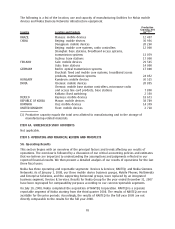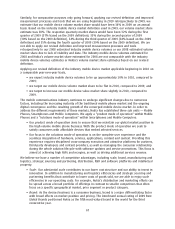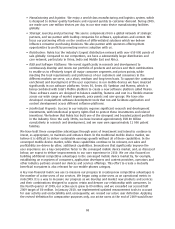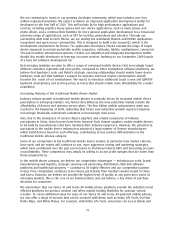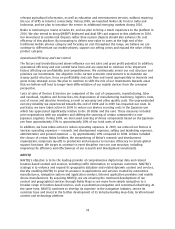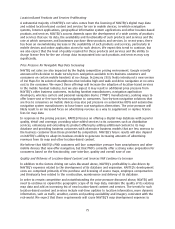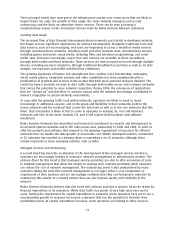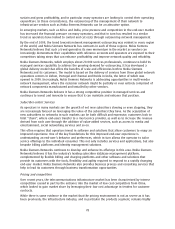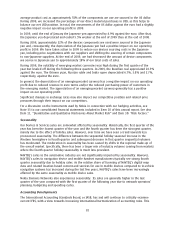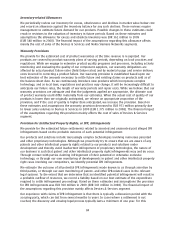Nokia 2009 Annual Report Download - page 77
Download and view the complete annual report
Please find page 77 of the 2009 Nokia annual report below. You can navigate through the pages in the report by either clicking on the pages listed below, or by using the keyword search tool below to find specific information within the annual report.LocationBased Products and Services Proliferating
A substantial majority of NAVTEQ’s net sales comes from the licensing of NAVTEQ’s digital map data
and related locationbased content and services for use in mobile devices, invehicle navigation
systems, Internet applications, geographical information system applications and other locationbased
products and services. NAVTEQ’s success depends upon the development of a wide variety of products
and services that use its data, the availability and functionality of such products and services and the
rate at which consumers and businesses purchase these products and services. In recent years, there
has been an overwhelming increase in the availability of such products and services, particularly in
mobile devices and online application stores for such devices. We expect this trend to continue, but
we also expect that the level of quality required for these products and services and the ability to
charge license fees for the use of map data incorporated into such products and services may vary
significantly.
Price Pressure for Navigable Map Data Increasing
NAVTEQ net sales are also impacted by the highly competitive pricing environment. Google recently
announced its decision to make turnbyturn navigation available to its business customers and
consumers on certain mobile handsets at no charge. In January 2010, Nokia introduced a new version
of Ovi Maps for its selected smartphones that includes highend walk and drive navigation at no extra
cost to the consumer. We expect these offerings will increase the adoption of locationbased services
in the mobile handset industry, but we also expect it may result in additional price pressure from
NAVTEQ’s other business customers, including handset manufacturers, navigation application
developers, wireless carriers and personal navigation device (“PND”) manufacturers, seeking ways to
offer lowercost or free turnbyturn navigation to consumers. Turnbyturn navigation solutions that
are free to consumers on mobile devices may also put pressure on automotive OEMs and automotive
navigation system manufacturers to have lower cost navigation alternatives. The price pressure will
likely result in an increased focus on advertising revenue as a way to supplement or replace license
fees for map data.
In response to the pricing pressure, NAVTEQ focuses on offering a digital map database with superior
quality, detail and coverage; providing valueadded services to its customers such as distribution
services; enhancing and extending its product offering by adding additional content to its map
database and providing business customers with alternative business models that are less onerous to
the business customer than those provided by competitors. NAVTEQ’s future results will also depend
on NAVTEQ’s ability to adapt its business models to generate increasing amounts of advertising
revenues from its map and other locationbased content.
We believe that NAVTEQ’s PND customers will face competitive pressure from smartphones and other
mobile devices that now offer navigation, but that PND’s currently offer a strong value proposition for
consumers based on the functionality, user interface, quality and overall ease of use.
Quality and Richness of LocationBased Content and Services Will Continue to Increase
In addition to the factors driving net sales discussed above, NAVTEQ’s profitability is also driven by
NAVTEQ’s expenses related to the development of its database and expansion. NAVTEQ’s development
costs are comprised primarily of the purchase and licensing of source maps, employee compensation
and thirdparty fees related to the construction, maintenance and delivery of its database.
In order to remain competitive and notwithstanding the price pressure discussed above, NAVTEQ will
need to continue to expand the geographic scope of its map data, maintain the quality of its existing
map data and add an increasing list of new locationbased content and services. The trends for such
locationbased content and services include realtime updates to location information, more dynamic
information, such as traffic, weather, events and parking availability and imagery consistent with the
realworld. We expect that these requirements will cause NAVTEQ’S map development expenses to
75


